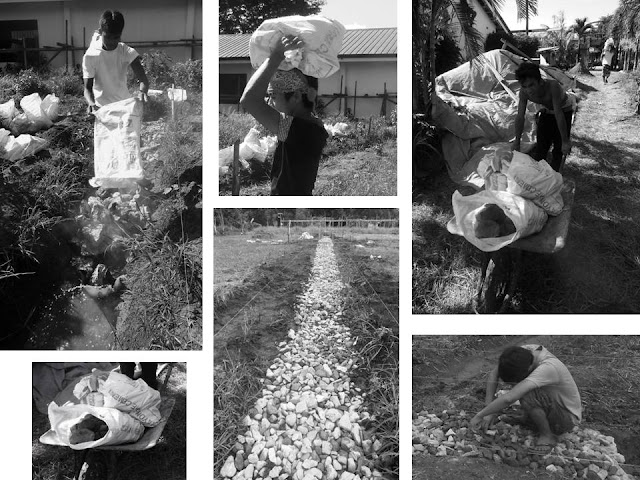A Challenge for Our Imagination
Recycled materials and some imagination are all you need to produce a beautiful and productive garden environment. Recently an offer too tempting to
refuse has got us scratching our heads and running to the drawing board in an
effort to prove our point.
The offer; An endless supply of broken glass, at a rock
bottom rate. Perhaps this offer doesn't sound to appealing yet, but we intend to turn that around, and once again we have been working hard together to convert a waste product into in integral part of our garden design.
Bringing Glass back to LIfe
At the centre of the garden will be an area designated for seating and flowering plants. Being at the very centre of the garden, this area will act as its heart, the core from where all paths radiate. The idea is to allow for a calm space which will encourage visitors to stop, relax and ultimately to process the concepts of organic production going on around them. In this space we intend the ground surface material to be crushed glass. Taking our inspiration from the properties of glass, we hope to create a space of light , texture, and reflection.
With glass as our inspiration, deciding to incorporate this beautiful resource into our garden was the easy bit,
the point of difficulty is in its conversion from junk to treasure.
In search of a smart solution to our new challenge, we have recently become greatly inspired by the concept of biomimicry - in other words - imitating the systems and models of nature and using these designs and processes to solve human problems. Here at the garden we are quickly learning that in copying natures processes and functions are able to see our problems in an entirely new way. With this in mind we took the erosive capacity of the sea as our prefered way of making our rather dangerous sharp glass into beautiful smooth pieces.
This research and new approach supported our goal, showing with the aid of movement, sand, water and rocks, we could mimic the erosive actions of the sea, and in turn we could use glass as a viable material with which to make a new ground surface in our garden...so, as usual here in the garden, in the name of experimentation we have created something slightly
different.
Construction
Our first job was to head to the
workshop and convince the staff there to help us with our experiment.
Always happy to support our crazy ideas, the mechanics and welders helped us seek out some disused
metal to morph into our new "glass smoothing" instruments.
A few operations later and we
had attached a handle, a hook and a metal paddle to a very heavy steel pole. We had created our new stirrer.
The next step was to construct the stirring environment, in effect our own little erosive sea. We placed a metal drum underneath
an A-frame, to which we attached our brand new “stirrer”.
The metal drum was filled 1/9th water, added 30kg
of rock, 1 bucket of sand and 20kg of broken glass.
The idea is to create a product not unlike the glass you find washed up on the beach, smooth, safe and attractive. In utilising the drum filled with sand, water and rocks, we have taken the concept of the natural smoothing process but hope to accelerate it with use of our new stirring instrument and a confined space. We are taking the processes of nature and bringing them to the human scale to solve human problems - biomimicry in action.
Let the Experiment Begin
The last step in our glass conversion is the manual mixing
of the materials. This step is speculative; we are not sure how long we will need to
manually mix the glass, sand and rocks in order to create a safe product. We are not
sure if this experiment will prove a success or leave us to begin
our search for a cement mixer. This is after all the Philippine Organic Garden Project, so of course we are willing to try and to experiment and we are confident that our natural and organic approach to garden design and resource use will prove an overwhelming success.
As always we are open to all ideas and suggestions...







.JPG)






























